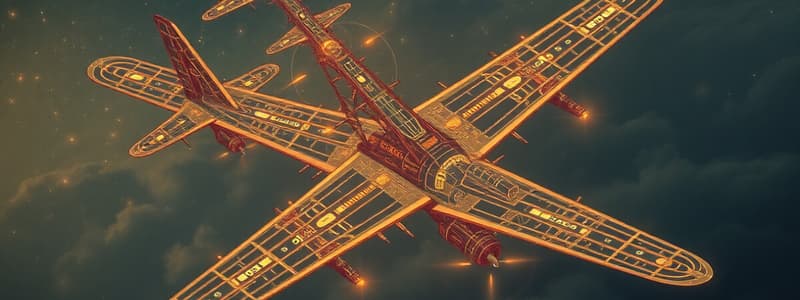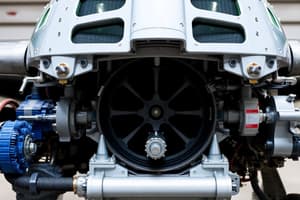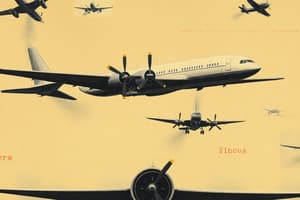Podcast
Questions and Answers
Which of the following is NOT a main section of a mechanical flight control system?
Which of the following is NOT a main section of a mechanical flight control system?
- Input/handling device
- Transmitting system/device
- Fuselage attachment (correct)
- Control surface
What is the primary function of control columns or wheels in an aircraft?
What is the primary function of control columns or wheels in an aircraft?
- To steer the nose wheel
- To move the ailerons and elevators (correct)
- To adjust trim settings
- To control the rudder and brakes
On larger aircraft, where are secondary control inputs, trim, and autopilot switches typically located?
On larger aircraft, where are secondary control inputs, trim, and autopilot switches typically located?
- Overhead panel
- On the center pedestal and control wheel (correct)
- On the rudder pedals
- On the instrument panel
Which of the following is NOT a component of the transmitting system in the mechanical flight control system?
Which of the following is NOT a component of the transmitting system in the mechanical flight control system?
What is the main difference between Corrosion Resistant Steel (CRES) and carbon steel control cables?
What is the main difference between Corrosion Resistant Steel (CRES) and carbon steel control cables?
What do the numbers in cable specifications like '7 x 19' indicate?
What do the numbers in cable specifications like '7 x 19' indicate?
In what application is non-flexible cable best suited?
In what application is non-flexible cable best suited?
What is the minimum cable size that should be used in a primary flight control system?
What is the minimum cable size that should be used in a primary flight control system?
What standards are Swage-type terminals manufactured in accordance with?
What standards are Swage-type terminals manufactured in accordance with?
Following the Nicopress cable splicing process, what instructions must be followed to ensure proper functioning and strength?
Following the Nicopress cable splicing process, what instructions must be followed to ensure proper functioning and strength?
During cable inspection, what areas are considered critical fatigue areas?
During cable inspection, what areas are considered critical fatigue areas?
When is it necessary to replace a control cable due to broken strands?
When is it necessary to replace a control cable due to broken strands?
What should be applied sparingly to a cable after cleaning to prevent corrosion?
What should be applied sparingly to a cable after cleaning to prevent corrosion?
Why should steel wool not be used when cleaning control cables?
Why should steel wool not be used when cleaning control cables?
What should an inspector do if a cable is found with surface corrosion?
What should an inspector do if a cable is found with surface corrosion?
When checking cable tension, why is it important to use the correct riser?
When checking cable tension, why is it important to use the correct riser?
What action should be taken if a cable is long when checking its tension?
What action should be taken if a cable is long when checking its tension?
Before using a tensiometer, why must it be calibrated?
Before using a tensiometer, why must it be calibrated?
What should NOT be done with turnbuckles to develop their full strength?
What should NOT be done with turnbuckles to develop their full strength?
What happens if turnbuckle barrels can not be adjusted without too many threads showing or a long barrel is used?
What happens if turnbuckle barrels can not be adjusted without too many threads showing or a long barrel is used?
What purpose do locking clips serve in modern turnbuckles?
What purpose do locking clips serve in modern turnbuckles?
What is a disadvantage of using locking wire for turnbuckle protection?
What is a disadvantage of using locking wire for turnbuckle protection?
When inspecting turnbuckles, what should be checked?
When inspecting turnbuckles, what should be checked?
What is commonly made of Phenolic for cable pulleys because of its properties?
What is commonly made of Phenolic for cable pulleys because of its properties?
What is the purpose of guards on cable pulleys?
What is the purpose of guards on cable pulleys?
What should be examined when inspecting pulley bearings?
What should be examined when inspecting pulley bearings?
What should be done during the inspection of pulleys?
What should be done during the inspection of pulleys?
What can result when pulleys have excessive cable tension?
What can result when pulleys have excessive cable tension?
How do bell cranks change motion?
How do bell cranks change motion?
What degree are bell cranks commonly found at?
What degree are bell cranks commonly found at?
What action occurs in a bell crank when one arm is pulled or pushed?
What action occurs in a bell crank when one arm is pulled or pushed?
What is a cable quadrant considered as?
What is a cable quadrant considered as?
What is the rotation range for cables limited to?
What is the rotation range for cables limited to?
The cable quadrant is similar to a two-armed lever, but what maintains constant length?
The cable quadrant is similar to a two-armed lever, but what maintains constant length?
Flashcards
Aircraft control column/wheel purpose
Aircraft control column/wheel purpose
Control columns/wheels share the same purpose: move the ailerons and elevators within the lateral and longitudinal axes. They are commonly used in light aircraft.
Aircraft pedal functions
Aircraft pedal functions
Control of the yaw axis is achieved through pedals. These pedals typically serve two or three functions, including rudder control, landing gear brake actuation, and nose wheel steering.
Aircraft flap lever function
Aircraft flap lever function
The flap lever provides an alternate form of control to trim motors, and in addition assist with automatic controls.
Aircraft control cable materials
Aircraft control cable materials
Signup and view all the flashcards
CRES cable benefits
CRES cable benefits
Signup and view all the flashcards
Non-flexible cable application
Non-flexible cable application
Signup and view all the flashcards
Extra-flexible cable application
Extra-flexible cable application
Signup and view all the flashcards
Swage terminal standards
Swage terminal standards
Signup and view all the flashcards
Critical fatigue areas on aircraft cables
Critical fatigue areas on aircraft cables
Signup and view all the flashcards
Aircraft cable riser size
Aircraft cable riser size
Signup and view all the flashcards
Aircraft turnbuckle material and purpose
Aircraft turnbuckle material and purpose
Signup and view all the flashcards
Aircraft turnbuckle thread exposure
Aircraft turnbuckle thread exposure
Signup and view all the flashcards
Modern turnbuckle anti-twist protection
Modern turnbuckle anti-twist protection
Signup and view all the flashcards
Aircraft pulley materials
Aircraft pulley materials
Signup and view all the flashcards
Most common pulley material
Most common pulley material
Signup and view all the flashcards
Aircraft pulley guard function
Aircraft pulley guard function
Signup and view all the flashcards
Aircraft bell crank function
Aircraft bell crank function
Signup and view all the flashcards
Aircraft cable quadrant components
Aircraft cable quadrant components
Signup and view all the flashcards
Study Notes
Mechanical Flight Control System Sections
- A flight control system contains three main sections.
- These sections are the input/handling device, the transmitting system/device, and the control surface.
Input/Handling Device
- Control columns or wheels serve the purpose of moving the ailerons and elevators.
- They operate within the lateral and longitudinal axes and are common in light aircraft.
- Pedals control the yaw axis and have two or three functions.
- These functions include rudder control, landing gear brake actuation, and nose wheel steering.
Additional Input Devices
- Main control input assemblies have additional components.
- These components include trim wheels for all three control directions.
- Flap levers are also included.
- Electrical switches are present for alternate control of trim motors and automatic controls.
- Secondary control inputs on large aircraft are located at the center pedestal and the trim and autopilot switches at the control wheel.
- The flap and spoiler levers are a part of the additional components on large aircraft.
Transmitting Systems/Devices
- Transmitting systems consist of control cables, cable drums, pulleys, turnbuckles, tension regulators, and cable quadrants.
- Control rods, levers, and cranks also constitute the system.
- Complete control servo systems with hydraulic power supply and valves are included.
Control Surface
- Early aircraft generations used conventional mechanical controls to move control surfaces.
- They consist of cables, chains, and torque tubes.
- The control surface is operated by a conventional control column, control wheel, pedal, and lever.
- Operation is instinctive to the pilot.
Control System Components - Cables
- Aircraft control cables are available in both Corrosion Resistant Steel (CRES) and Carbon Steel.
- CRES cables are more expensive and have lower strength compared to carbon steel, but are more appropriate when corrosion is a factor.
Cable Types
- There are three main types of cable: non-flexible, flexible, and extra-flexible.
- Non-flexible cables are 1X7 or 1X19.
- Flexible cables are 7X7.
- Extra-flexible cables are 7X19.
- The numbers indicate the number of bundles or strands and the number of wires in each strand.
Cable Applications
- Non-flexible cables are used for straight runs where the cable does not run over pulleys.
- Used often as a push-pull cable for engine controls or environmental controls.
- These cables are often encased in an outer sheath, similar to a bicycle cable.
- Flexible cables are suitable for straight runs with large pulleys if extreme flexing is not required.
- Extra-flexible cables are used for primary flight control systems.
- The minimum cable size for primary control systems is 1/8 inch.
Cable Terminals
- Swage-type terminals are manufactured according to Army-Navy (AN) and Military Standards (MS).
- Swage-type terminals are suitable for civil aircraft up to maximum cable loads.
- Instructions for swaging tools, including 'go' and 'no-go' dimensions, are followed.
- Doing so exactly avoids defective swaging.
- When using the gauge, the opening must be the minimum size and the other the maximum.
Cable End and Splice
- The Nicopress cable termination using copper sleeves can be used to the full rated strength of the cable when looped around a thimble.
- Tools, instructions, and data supplied by the manufacturer must be followed when using the Nicopress process for cable splicing.
- Doing so ensures the desired cable function and strength.
- Nicopress and cable-cutting instructions are within the AS-70-3 Training Board.
- The cable used with training aids measures 1/16" in diameter and requires a single swage.
- The order of the 3 swaged nicopress points is standard for all other sizes.
Cable Inspection and Servicing
- Always refer to the Aircraft Maintenance Manual (AMM) for specific criteria.
- Inspections occur during annual inspections or specific intervals set by the aircraft manufacturer.
- Inspection intervals may need to increase due to operating environments (saltwater).
- Critical fatigue areas are where the cable runs over, under, or around a pulley, sleeve, or fairlead.
- Critical fatigue areas include sections where the cable is flexed, rubbed, or worked in any manner, or within 1 foot of a swaged fitting.
Cable Inspection Continued
- Check control cables for condition, attachment, alignment, clearance, and proper operation.
- Replace cables that have three or more broken strands along any three-foot segment, or evidence of corrosion anywhere on the cable.
- Any cable that has one broken wire strand in a critical fatigue area is replaced per AC43.13-1B.
- Inspect swage fittings for slippage e.g., paint marks, and broken wires at the swage from the swaging process per AC43.13-1B.
- Replace flexible/non-flexible cables when individual wires in each strand appear to blend, or if outer wires are worn 40-50% per AC43.13-1B.
- Avoid kinking cables, because a kinked cable cannot be fixed.
- Replace any cable that has a popped core or loose strands.
- Inspect cables in areas conducive to corrosion like battery compartments, lavatories, and wheel wells.
- Relieve tension and reverse-twist the cable to inspect inside if there is surface corrosion.
- If no internal corrosion exists, remove loose external rust/corrosion, using a fiber brush, not steel wool or solvents.
- Using steel wool will embed dissimilar metal particles in the cable, creating corrosion problems.
- Solvents will remove internal cable lubricant, which can cause cable strands to abrade.
- External surface wear indicates wear is also occurring internally, where cables pass over pulleys and bell cranks due to the relative motion between inner wire surfaces.
- After cable cleaning apply MIL-C-16173 grade 4 corrosion-preventive compound sparingly.
Cable Inspection Continued - Additional Checks
- Examine cable runs for incorrect routing, fraying, twisting or wear at fairleads, pulleys, anti-abrasion strips and guards.
- Check for interference with adjacent structure, equipment, wiring, plumbing, and other controls.
- Use a mirror to check difficult areas.
- Inspect front to back of the aircraft.
- Use another person to move controls while inspecting around pulleys.
- Use a string method when removing cables.
- Ensure all cable guides are reinstalled after cable replacement, and cables are not crossed anywhere.
Cable Tensioning
- Use the correct riser for the cable, typically risers #1, #2, and #3 are included for specific cable diameters.
- The British use different sizes of cables, so ensure CWT risers are used when necessary.
- Use a gauge or Vernier calipers if unsure of cable size.
- Do not take readings too close to an attachment point or a pulley.
- Take multiple readings and average them for long cables.
Cable Tensiometer Use
- Identify a suitable location to place the tension meter to measure cable tension.
- Raise the lever and hang the tension meter on the cable.
- Lower the lever gently until the cable is held by the tension meter.
- Take the reading displayed on the dial.
- Consult the chart provided by the manufacturer to find the tension corresponding to the cable diameter.
- If the cable diameter is unknown, use the cable diameter gauge located in the cable tension meter case.
Tensiometer Chart Use
- Tensiometers are measuring instruments that must be calibrated on a regular basis as per company approval manual.
- Because there are three different size risers for the different diameter cables, each diameter of cable will get a different reading for the same tension
- The chart reading corresponds to cable diameter (and respective riser) and the column.
- Read for actual tension based on the position relative to riser #1.
- Horizontally cross-reference the reading the tension column.
- If a value of 34 occurs using riser #1 on a 1/8" diameter cable, the tension is 35lbs.
Control System Components - Turnbuckles
- Turnbuckles are used to adjust cable tension.
- Consist of an externally threaded cable end and an internally threaded turnbuckle barrel.
- Each turnbuckle includes right and left-hand threads that are identifiable by a groove.
- A turnbuckle can be secured using wire-locking or a locking clip for safety.
- Brass is typically the metal of choice when making turnbuckles.
- Brass turnbuckles used to join two cables, allowing cables to be tensioned to the correct value.
- To reach its full strength, a turnbuckle has a maximum of three threads exposed at either end of its barrel.
- Turnbuckle barrels are available in two lengths.
- If there are too many threads showing, a longer barrel must be installed.
Control System Components - Locking Clips
- Anti-twist protection for modern turnbuckles exists in the form of clips.
- The threads on both the cable end and turnbuckle must have splines or a horizontal groove cut lengthwise.
- The design allows the parts and locking clip to interface, which allows for ultimate protection against twisting.
Control System Components - Locking Wire
- Older-style turnbuckle protection exists in the form of a lockwire.
- The system is available in both single and double-wire configurations.
- This design does not guarantee protection against twisting a little until the wire tightens.
Turnbuckle Inspection
- Inspect turnbuckles for proper thread exposure and cracks.
- Verify no safety wires or clips are missing or broken.
- For details on how to safety wire and use clips, refer to AC 43.13-1B pages 7-43 through 7-48.
Control System Components - Cable Pulleys
- Pulleys are made of Phenolic, phermica, aluminum or plastic.
- Phenolic is the most common material, with a ball or roller bearing pressed into the center.
- These are used to change the direction of a cable run or the length of a cable and to prevent cable vibration.
- They typically have guards to prevent the cable from falling out of the groove when slack.
- Pulleys have to be free to rotate throughout their full travel.
Pulley Inspection
- Inspect pulleys for roughness, sharp edges, and any foreign material embedded in the grooves.
- Examine pulley bearings for proper lubrication, smooth rotation, and freedom from flat spots, dirt, and paint spray.
- Rotate pulleys to provide a new bearing surface for the cable.
Pulley Inspection - Continued
- Check pulleys for wear, such as misalignment, excessive cable tension depressions, misalignment, and incorrect pulley size or flat spots.
- Inspect pulley brackets and guards for damage, alignment, and security.
Control System Components - Bellcranks
- A bell crank changes motion through an angle.
- The angle can be any angle between 0 and 360 degrees.
- 90 degrees 180 degrees are more common.
- Pulling or pushing one arm rotates the bar around the pivot point, pulling or pushing on the other arm.
Control System Components - Cable Quadrant
- A cable quadrant is like a flat cable drum which only allows a few degrees of rotation.
- It has a similar operation to a two-armed lever with a constant lever arm.
Studying That Suits You
Use AI to generate personalized quizzes and flashcards to suit your learning preferences.


